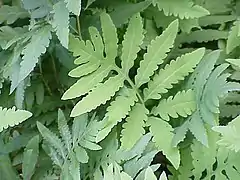Filicopsida
La classe des Filicopsida regroupe la plupart des fougères connues actuellement. D'après ITIS, cette classe est invalide et est remplacée par la classe des Polypodiopsida.
Sous-classes
Classe des Polypodiopsida :
Selon ITIS (12 janvier 2018)[1] :
- Sous-classe Equisetidae
- Sous-classe Marattiidae
- Sous-classe Ophioglossidae
- Sous-classe Polypodiidae
Classification
Les Leptosporangiates comprennent la grande majorité des fougères existantes (dont fougères grimpantes). Seuls les groupes qui bifurquèrent au début de la différenciation de la lignée des fougères et qui conservent un eusporange n’y sont pas inclus. Une classification proposée par Smith et al. 2006 et Christenhusz et al. en 2011[2] est la suivante :
- Ordre Osmundales (royal ferns)
- Famille Osmundaceae
- Ordre Hymenophyllales (filmy ferns and bristle ferns)
- Famille Hymenophyllaceae (incl. Trichomanaceae)
- Ordre Gleicheniales
- Famille Gleicheniaceae (incl. Dicranopteridaceae, Stromatopteridaceae)
- Famille Dipteridaceae (incl. Cheiropleuriaceae)
- Famille Matoniaceae
- Ordre Schizaeales
- Famille Lygodiaceae
- Famille Anemiaceae (incl. Mohriaceae)
- Famille Schizaeaceae
- Ordre Salviniales
- Famille Marsileaceae (incl. Pilulariaceae)
- Famille Salviniaceae (incl. Azollaceae)
- Ordre Cyatheales
- Famille Thyrsopteridaceae
- Famille Loxsomataceae
- Famille Culcitaceae
- Famille Plagiogyriaceae
- Famille Cibotiaceae
- Famille Cyatheaceae (incl. Alsophilaceae, Hymenophyllopsidaceae[3])
- Famille Dicksoniaceae (incl. Lophosoriaceae)
- Famille Metaxyaceae
- Ordre Polypodiales
- Famille Lonchitidaceae[2]
- Famille Lindsaeaceae
- Famille Saccolomataceae
- Famille Cystodiaceae[2]
- Famille Dennstaedtiaceae (incl. Hypolepidaceae, Monachosoraceae, Pteridiaceae)
- Famille Pteridaceae (incl. Acrostichaceae, Actiniopteridaceae, Adiantaceae, Anopteraceae, Antrophyaceae, Ceratopteridaceae, Cheilanthaceae, Cryptogrammaceae, Hemionitidaceae, Negripteridaceae, Parkeriaceae, Platyzomataceae, Sinopteridaceae, Taenitidaceae, Vittariaceae)
- Famille Diplaziopsidaceae X.C.Zhang & Christenh. 2011[4]
- Clade eupolypods II in Smith 2006 (Autrefois, Blechnales, Athyriales, Aspleniales, ou Thelypteridales)
- Famille Cystopteridaceae Schmakov 2001
- Famille Aspleniaceae Newman 1840
- Famille Hemidictyaceae Christenh. 2011[4] - [5]
- Famille Thelypteridaceae Pic.Serm. 1970
- Famille Rhachidosoraceae X.C.Zhang 2011[2]
- Famille Woodsiaceae Herter 1949
- Famille Onocleaceae Pic.Serm. 1970
- Famille Blechnaceae Newman 1844 (incl. Stenochlaenaceae)
- Famille Athyriaceae Alston 1956
- Clade eupolypods I in Smith 2006
- Famille Dryopteridaceae (incl. Aspidiaceae, Bolbitidaceae, Elaphoglossaceae, Hypodematiaceae, Peranemataceae)
- Famille Lomariopsidaceae
- Famille Nephrolepidaceae[2]
- Famille Tectariaceae
- Famille Oleandraceae
- Famille Davalliaceae
- Famille Polypodiaceae (incl. Drynariaceae, Grammitidaceae, Gymnogrammitidaceae, Loxogrammaceae, Platyceriaceae, Pleursoriopsidaceae)
Notes et références
- Integrated Taxonomic Information System (ITIS), www.itis.gov, CC0 https://doi.org/10.5066/F7KH0KBK, consulté le 12 janvier 2018
- Christenhusz, M.J.M., Zhang, X.C. & Schneider, H. (2011). "A linear sequence of extant families and genera of lycophytes and ferns", Phytotaxa 19 : 5-22
- Christenhusz, M.J.M. (2009). "New combinations and an overview of Cyathea subg. Hymenophyllopsis (Cyatheaceae)" Phytotaxa 1: 37-42
- Lehtonen S (2011). "Towards Resolving the Complete Fern Tree of Life". PLoS ONE 6 (10): e24851. Doi:10.1371/journal.pone.0024851
- Christenhusz et al. (2011c) Christenhusz & Schneider: "Corrections to Phytotaxa 19: Linear sequence of lycophytes and ferns", (14 Sept. 2011)
Liens externes
- (fr+en) Référence ITIS : Filicopsida Non valide
- (fr+en) Référence ITIS : Polypodiopsida
- (en) Référence NCBI : Polypodiopsida (taxons inclus)
- (en) Référence Tree of Life Web Project : Filicopsida
- (fr) Référence Catalogue of Life : Filicopsida
- (en) Référence Paleobiology Database : Filicopsida
Cet article est issu de wikipedia. Text licence: CC BY-SA 4.0, Des conditions supplémentaires peuvent s’appliquer aux fichiers multimédias.
